国际内部审计专业实务框架培训资料(PPT 56张)
- 格式:ppt
- 大小:1.86 MB
- 文档页数:59
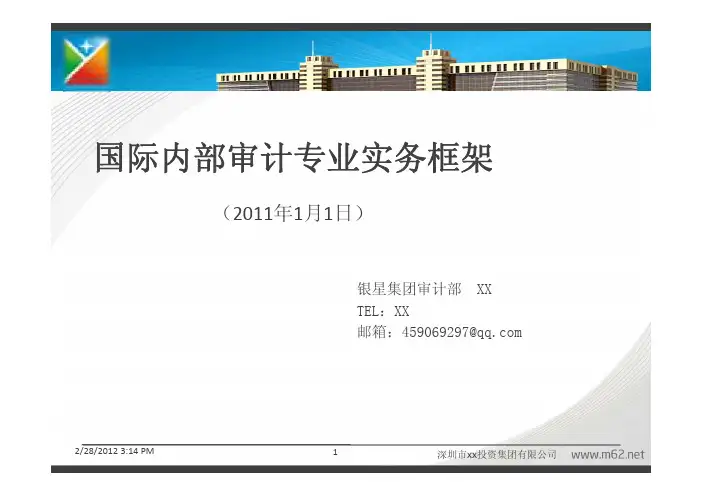
国际内部审计专业实务框架(2011年1月1日)银星集团审计部XXTEL:XX邮箱:459069297@2/28/2012 3:14 PM内部审计定义目职业道德规范录实务标准2/28/2012 3:14 PM国际内部审计师协会1987年11月,中国内部审计学会(2002年5月改名为中国内部审计协会)加入了国际内部审计师协会。
IIA网址:/2/28/2012 3:14 PM内部审计观念传统观念◆成本中心◆非增值部门非增值部◆负责「寻找麻烦」的工作,小事化大◆工作不受重视◆是一个可有可无的部门是个可有可无的部门后果◆内部控制缺乏客观性◆可能因其它工作压力而被忽视◆董事会得到的信心保证大减◆经营风险上升◆内部控制过程严重崩溃2/28/2012 3:14 PM世通公司内部审计师·CynthiaCooper)辛西娅库珀(Cynthia Cooper)2002年,揭发世通在以往年度隐瞒亏损,把应计当期费用资本化为固定资产,透过折旧把当期费用分年摊销入损益表。
调查结果,世通从2000和2001年度原审核净利润76亿美元和24 亿美元调整为净亏损489亿美元和92亿美元虚增资产少计费用及错计收入等共虚报利润高达亏损489亿美元和92 亿美元,虚增资产、少计费用及错计收入等共虚报利润高达740亿多美元。
公布利润需要作出调整之后,股价由最高64美元跌至最低0.9美元,裁减员工17,000人。
安然公司副总裁莎朗·沃特金斯(SherronWatkins)安然公司副总裁莎朗·沃特金斯(Sherron Watkins)2001年10月份,安然突然传出接近6亿美元亏损的季度财务报告。
调查结果,安然被迫承认做了假账,自1997年以来,虚报盈利大约6亿美元,并把即将到期的39亿美元的债务隐瞒了24亿美元。
2001年11月28日,曾高逾90美元的安然公司股票一天之内暴跌75%;两天后,又2001年11月28日,曾高逾90美元的安然公司股票天之内暴跌75%;两天后,又跌至每股0.26美元,股价缩水到不足高峰时期的0.3%。
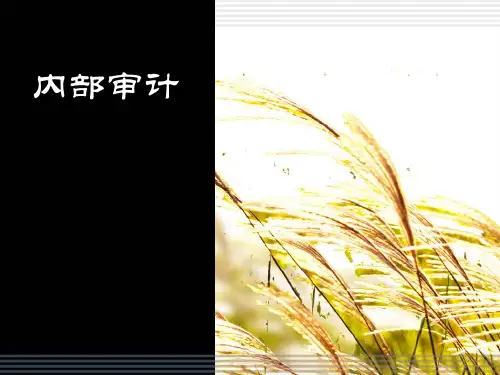
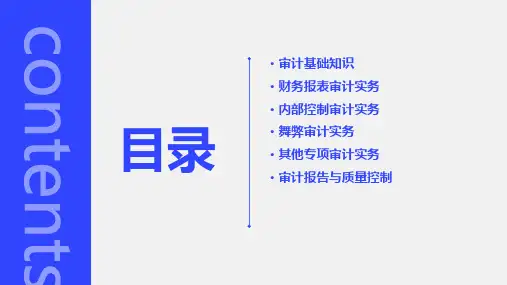
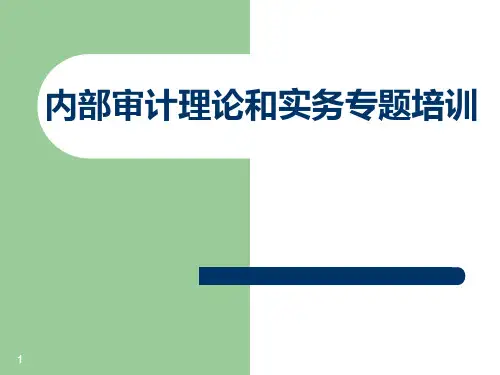
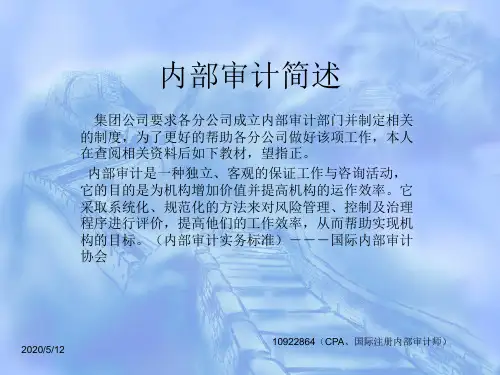
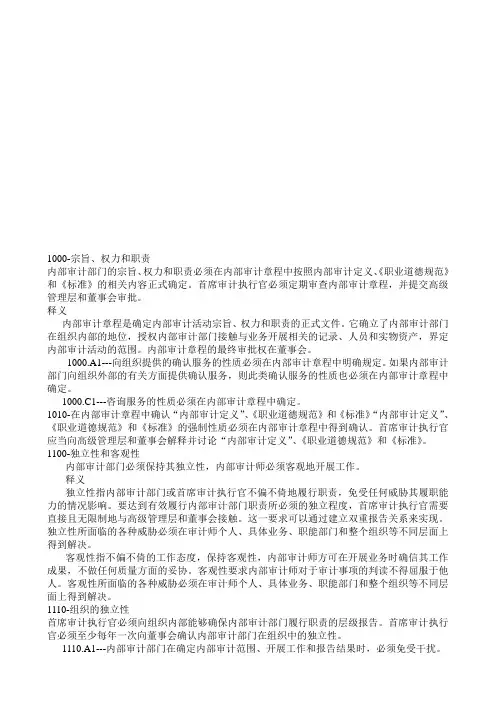
1000-宗旨、权力和职责内部审计部门的宗旨、权力和职责必须在内部审计章程中按照内部审计定义、《职业道德规范》和《标准》的相关内容正式确定。
首席审计执行官必须定期审查内部审计章程,并提交高级管理层和董事会审批。
释义内部审计章程是确定内部审计活动宗旨、权力和职责的正式文件。
它确立了内部审计部门在组织内部的地位,授权内部审计部门接触与业务开展相关的记录、人员和实物资产,界定内部审计活动的范围。
内部审计章程的最终审批权在董事会。
1000.A1---向组织提供的确认服务的性质必须在内部审计章程中明确规定。
如果内部审计部门向组织外部的有关方面提供确认服务,则此类确认服务的性质也必须在内部审计章程中确定。
1000.C1---咨询服务的性质必须在内部审计章程中确定。
1010-在内部审计章程中确认“内部审计定义”、《职业道德规范》和《标准》“内部审计定义”、《职业道德规范》和《标准》的强制性质必须在内部审计章程中得到确认。
首席审计执行官应当向高级管理层和董事会解释并讨论“内部审计定义”、《职业道德规范》和《标准》。
1100-独立性和客观性内部审计部门必须保持其独立性,内部审计师必须客观地开展工作。
释义独立性指内部审计部门或首席审计执行官不偏不倚地履行职责,免受任何威胁其履职能力的情况影响。
要达到有效履行内部审计部门职责所必须的独立程度,首席审计执行官需要直接且无限制地与高级管理层和董事会接触。
这一要求可以通过建立双重报告关系来实现。
独立性所面临的各种威胁必须在审计师个人、具体业务、职能部门和整个组织等不同层面上得到解决。
客观性指不偏不倚的工作态度,保持客观性,内部审计师方可在开展业务时确信其工作成果,不做任何质量方面的妥协。
客观性要求内部审计师对于审计事项的判读不得屈服于他人。
客观性所面临的各种威胁必须在审计师个人、具体业务、职能部门和整个组织等不同层面上得到解决。
1110-组织的独立性首席审计执行官必须向组织内部能够确保内部审计部门履行职责的层级报告。

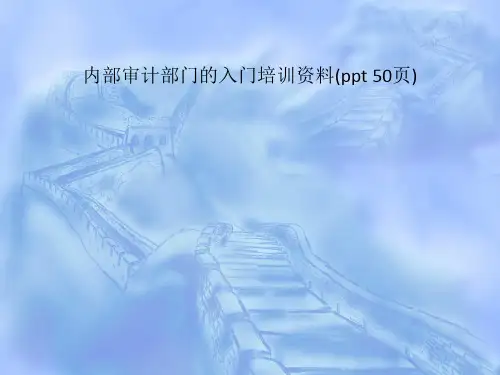
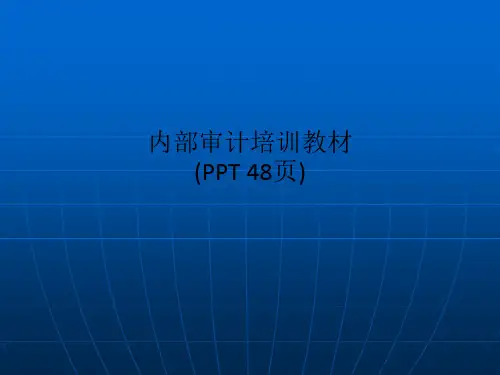
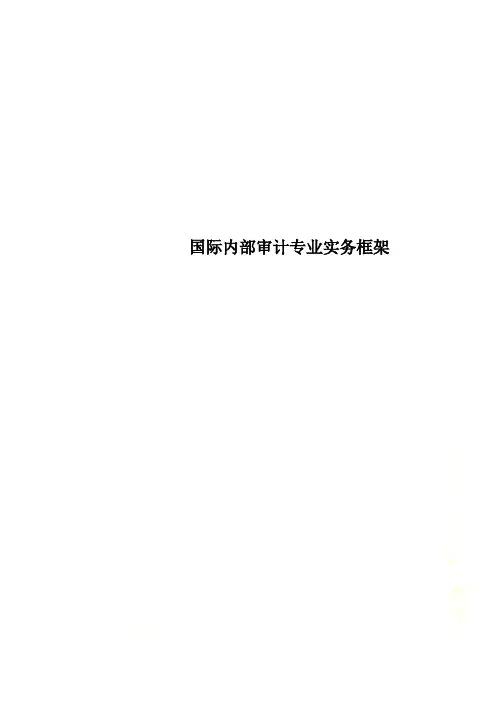
国际内部审计专业实务框架国际内部审计专业实务框架修订说明鉴于全球内部审计职业的快速发展,2006年国际内部审计师协会(IIA)理事会组建了筹划指导委员会和专门小组,重新审视《内部审计专业实务框架》(PPF)及相关制定过程,重点是回顾该专业实务框架的范围,增加专业标准制定、复核及颁布过程的透明度和一贯性。
专门小组的工作结果形成了全新的《国际内部审计专业实务框架》(IPPF)和重新改组的专业实务委员会(PPC)。
根据IIA理事会2007年6月批准的使命声明,专业实务委员会目前负责协调《国际内部审计专业实务框架》的审核与发布工作。
作为整合IIA所发布标准的概念性框架,《国际内部审计专业实务框架》的范围缩减到只包括由IIA国际技术委员会按照适当程序制定的权威标准。
该权威标准由以下两部分构成:强制性指南。
遵循强制性指南的原则对于内部审计专业实务是必须且重要的。
强制性指南的制定遵循既定的尽职审查程序,包括公布征求意见稿,广泛听取各界的意见。
《国际内部审计专业实务框架》的三个强制部分为“内部审计定义”、《职业道德规范》和《国际内部审计专业实务框架》(以下简称《标准》)。
强力推荐的指南。
强力推荐的指南是IIA通过正式批准程序认可的,阐述有效执行“内部审计定义”、《职业道德规范》和《标准》的实务,包括立场公告、实务公告和实务指南。
新版IPPF所作的重大改变是:(l)程序改进。
加强了IPPF的各个部分,提高了透明度并确定了权威标准的修订周期。
标准的修订周期目前确定为三年,尽管并非每三年都需要进行修改,IIA仍致力于确保对标准作全面的审核,并视需要进行修订。
(2)发展与实务帮助。
这一部分不再纳入框架体系。
它曾经包含了内部审计师在工作过程中可能会用到的所有资源(例如培训、出版物和研究报告等)。
由于新版IPPF的范围只包括上述的权威标准,这项内容不再适合于新的框架。
(3)释义。
这是新增的对标准中的术语和短语作出的进一步阐释,置于需要加以解释的相关标准条款之下。
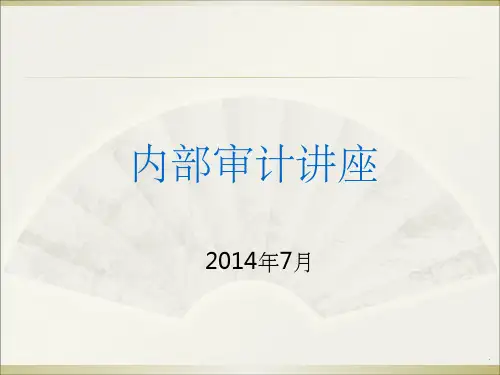
INTERNATIONAL STANDARDS FOR THE PROFESSIONALPRACTICE OFINTERNAL AUDITING (STANDARDS)Introduction to the International StandardsInternal auditing is conducted in diverse legal and cultural environments; within organizations that vary in purpose, size, complexity, and structure; and by persons within or outside the organization. While differences may affect the practice of internal auditing in each environment, conformance with The IIA’s International Standards for the Professional Practice of Internal Auditing (Standards) is essential in meeting the responsibilities of internal auditors and the internal audit activity.If internal auditors or the internal audit activity is prohibited by law or regulation from conformance with certain parts of the Standards, conformance with all other parts of the Standards and appropriate disclosures are needed.If the Standards are used in conjunction with standards issued by other authoritative bodies, internal audit communications may also cite the use of other standards, as appropriate. In such a case, if inconsistencies exist between the Standards and other standards, internal auditors and the internal audit activity must conform with the Standards, and may conform with the other standards if they are more restrictive.The purpose of the Standards is to:1. Delineate basic principles that represent the practice of internalauditing.2. Provide a framework for performing and promoting a broadrange of value-added internal auditing.Issued: October 2008 Page 1 of 353. Establish the basis for the evaluation of internal auditperformance.4. Foster improved organizational processes and operations.The Standards are principles-focused, mandatory requirements consisting of:∙Statements of basic requirements for the professional practice of internal auditing and for evaluating the effectiveness of performance, which are internationally applicable at organizational and individual levels.∙Interpretations, which clarify terms or concepts within the Statements.The Standards employ terms that have been given specific meanings that are included in the Glossary. Specifically, the Standards use the word ―must‖ to specify an unconditional requirement and the word ―should‖ where conformance is expected unless, when applying professional judgment, circumstances justify deviation.It is necessary to consider the Statements and their Interpretations as well as the specific meanings from the Glossary to understand and apply the Standards correctly.The structure of the Standards is divided between Attribute and Performance Standards. Attribute Standards address the attributes of organizations and individuals performing internal auditing. The Performance Standards describe the nature of internal auditing and provide quality criteria against which the performance of these services can be measured. The Attribute and Performance Standards are also provided to apply to all internal audit services. Implementation Standards are also provided to expand upon the Attribute and Performance standards, by providing the requirements applicable to assurance (A) or consulting (C) activities.Assurance services involve the internal auditor’s objective assessment of evidence to provide an independent opinion or conclusionsregarding an entity, operation, function, process, system, or other subject matter. The nature and scope of the assurance engagement are determined by the internal auditor. There are generally three parties involved in assurance services: (1) the person or group directly involved with the entity, operation, function, process, system, or other subject matter — the process owner, (2) the person or group making the assessment —the internal auditor, and (3) the person or group using the assessment — the user.Consulting services are advisory in nature, and are generally performed at the specific request of an engagement client. The nature and scope of the consulting engagement are subject to agreement with the engagement client. Consulting services generally involve two parties: (1) the person or group offering the advice —the internal auditor, and (2) the person or group seeking and receiving the advice —the engagement client. When performing consulting services the internal auditor should maintain objectivity and not assume management responsibility.The review and development of the Standards is an ongoing process. The Internal Audit Standards Board engages in extensive consultation and discussion prior to issuing the Standards. This includes worldwide solicitation for public comment through the exposure draft process. All exposure dr afts are posted on The IIA’s Web site as well as being distributed to all IIA institutes.Suggestions and comments regarding the Standards can be sent to:The Institute of Internal AuditorsStandards and Guidance247 Maitland AvenueAltamonte Springs, FL 32701-4201, USAE-mail: guidance@ Web: ***INTERNATIONAL STANDARDS FOR THE PROFESSIONALPRACTICEOF INTERNAL AUDITING (STANDARDS)Attribute Standards1000 – Purpose, Authority, and ResponsibilityThe purpose, authority, and responsibility of the internal audit activity must be formally defined in an internal audit charter, consistent with the Definition of Internal Auditing, the Code of Ethics, and the Standards. The chief audit executive must periodically review the internal audit charter and present it to senior management and the board for approval.Interpretation:The internal audit charter is a formal document that defines the internal audit activity's purpose, authority, and responsibility. The internal audit charter establishes the internal audit activity's position within the organization, including the nature of the chief audit executive’s functional reporting relationship with the board; authorizes access to records, personnel, and physical properties relevant to the performance of engagements; and defines the scope of internal audit activities. Final approval of the internal audit charter resides with the board.1000.A1 –The nature of assurance services provided to the organization must be defined in the internal audit charter. If assurances are to be provided to parties outside the organization, the nature of these assurances must also be defined in the internal audit charter.1000.C1 – The nature of consulting services must be defined in the internal audit charter.1010 –Recognition of the Definition of Internal Auditing, the Code of Ethics, and the Standards in the Internal Audit Charter The mandatory nature of the Definition of Internal Auditing, the Code of Ethics, and the Standards must be recognized in the internal audit charter. The chief audit executive should discuss the Definition of Internal Auditing, the Code of Ethics, and the Standards with senior management and the board.1100 – Independence and ObjectivityThe internal audit activity must be independent, and internal auditors must be objective in performing their work.Interpretation:Independence is the freedom from conditions that threaten the ability of the internal audit activity to carry out internal audit responsibilities in an unbiased manner. To achieve the degree of independence necessary to effectively carry out the responsibilities of the internal audit activity, the chief audit executive has direct and unrestricted access to senior management and the board. This can be achieved through a dual-reporting relationship. Threats to independence must be managed at the individual auditor, engagement, functional, and organizational levels.Objectivity is an unbiased mental attitude that allows internal auditors to perform engagements in such a manner that they believe in their work product and that no quality compromises are made. Objectivity requires that internal auditors do not subordinate their judgment on audit matters to others. Threats to objectivity must be managed at the individual auditor, engagement, functional, and organizational levels. 1110 – Organizational IndependenceThe chief audit executive must report to a level within the organization that allows the internal audit activity to fulfill its responsibilities. The chief audit executive must confirm to the board, at least annually, the organizational independence of the internal audit activity.Interpretation:Organizational independence is effectively achieved when the chief audit executive reports functionally to the board. Examples of functional reporting to the board involve the board:∙Approving the internal audit charter;∙Approving the risk based internal audit plan;∙Receiving communications from the chief audit executive on the internal audit activity’s performance relative to its plan and other matters;∙Approving decisions regarding the appointment and removal of the chief audit executive; and∙Making appropriate inquiries of management and the chief audit executive to determine whether there are inappropriate scope or resource limitations.1110.A1 –The internal audit activity must be free from interference in determining the scope of internal auditing, performing work, and communicating results.1111 – Direct Interaction with the BoardThe chief audit executive must communicate and interact directly with the board.1120 – Individual ObjectivityInternal auditors must have an impartial, unbiased attitude and avoid any conflict of interest.Interpretation:Conflict of interest is a situation in which an internal auditor, who is in a position of trust, has a competing professional or personal interest. Such competing interests can make it difficult to fulfill his or her duties impartially. A conflict of interest exists even if no unethical or improper act results. A conflict of interest can create an appearance of impropriety that can undermine confidence in the internal auditor, the internal audit activity, and the profession. A conflict of interest couldimpair an individual's ability to perform his or her duties and responsibilities objectively.1130 – Impairment to Independence or ObjectivityIf independence or objectivity is impaired in fact or appearance, the details of the impairment must be disclosed to appropriate parties. The nature of the disclosure will depend upon the impairment. Interpretation:Impairment to organizational independence and individual objectivity may include, but is not limited to, personal conflict of interest, scope limitations, restrictions on access to records, personnel, and properties, and resource limitations, such as funding.The determination of appropriate parties to which the details of an impairment to independence or objectivity must be disclosed is dependent upon the expectations of the internal audit activity’s and the chief audit executive’s responsibilities to senior managem ent and the board as described in the internal audit charter, as well as the nature of the impairment.1130.A1 – Internal auditors must refrain from assessing specificoperations for which they were previously responsible.Objectivity is presumed to be impaired if an internal auditorprovides assurance services for an activity for which the internalauditor had responsibility within the previous year.1130.A2 – Assurance engagements for functions over which thechief audit executive has responsibility must be overseen by aparty outside the internal audit activity.1130.C1–Internal auditors may provide consulting servicesrelating to operations for which they had previous responsibilities.1130.C2–If internal auditors have potential impairments toindependence or objectivity relating to proposed consultingservices, disclosure must be made to the engagement client prior to accepting the engagement.1200 – Proficiency and Due Professional CareEngagements must be performed with proficiency and due professional care.1210 – ProficiencyInternal auditors must possess the knowledge, skills, and other competencies needed to perform their individual responsibilities. The internal audit activity collectively must possess or obtain the knowledge, skills, and other competencies needed to perform its responsibilities.Interpretation:Knowledge, skills, and other competencies is a collective term that refers to the professional proficiency required of internal auditors to effectively carry out their professional responsibilities. Internal auditors are encouraged to demonstrate their proficiency by obtaining appropriate professional certifications and qualifications, such as the Certified Internal Auditor designation and other designations offered by The Institute of Internal Auditors and other appropriate professional organizations.1210.A1–The chief audit executive must obtain competent advice and assistance if the internal auditors lack the knowledge, skills, or other competencies needed to perform all or part of the engagement.1210.A2 – Internal auditors must have sufficient knowledge to evaluate the risk of fraud and the manner in which it is managed by the organization, but are not expected to have the expertise ofa person whose primary responsibility is detecting andinvestigating fraud.1210.A3–Internal auditors must have sufficient knowledge of key information technology risks and controls and available technology-based audit techniques to perform their assigned work. However, not all internal auditors are expected to have the expertise of an internal auditor whose primary responsibility is information technology auditing.1210.C1 – The chief audit executive must decline the consulting engagement or obtain competent advice and assistance if the internal auditors lack the knowledge, skills, or other competencies needed to perform all or part of the engagement.1220 – Due Professional CareInternal auditors must apply the care and skill expected of a reasonably prudent and competent internal auditor. Due professional care does not imply infallibility.1220.A1– Internal auditors must exercise due professional care by considering the:∙Extent of work needed to achieve the engagement’s objectives;∙Relative complexity, materiality, or significance of matters to which assurance procedures are applied;∙Adequacy and effectiveness of governance, risk management, and control processes;∙Probability of significant errors, fraud, or noncompliance;and∙Cost of assurance in relation to potential benefits.1220.A2–In exercising due professional care internal auditors must consider the use of technology-based audit and other data analysis techniques.1220.A3– Internal auditors must be alert to the significant risks that might affect objectives, operations, or resources. However,assurance procedures alone, even when performed with due professional care, do not guarantee that all significant risks will be identified.1220.C1– Internal auditors must exercise due professional care during a consulting engagement by considering the:∙Needs and expectations of clients, including the nature, timing, and communication of engagement results;∙Relative complexity and extent of work needed to achieve the engagement’s objectives; and∙Cost of the consulting engagement in relation to potential benefits.1230 – Continuing Professional DevelopmentInternal auditors must enhance their knowledge, skills, and other competencies through continuing professional development.1300 – Quality Assurance and Improvement ProgramThe chief audit executive must develop and maintain a quality assurance and improvement program that covers all aspects of the internal audit activity.Interpretation:A quality assurance and improvement program is designed to enable an evaluation of the internal audit activity’s conformance with the Definition of Internal Auditing and the Standards and an evaluation of whether internal auditors apply the Code of Ethics. The program also assesses the efficiency and effectiveness of the internal audit activity and identifies opportunities for improvement.1310 – Requirements of the Quality Assurance and Improvement ProgramThe quality assurance and improvement program must include both internal and external assessments.1311 – Internal AssessmentsInternal assessments must include:∙Ongoing monitoring of the performance of the internal audit activity; and∙Periodic reviews performed through self-assessment or by other persons within the organization with sufficient knowledge of internal audit practices.Interpretation:Ongoing monitoring is an integral part of the day-to-day supervision, review, and measurement of the internal audit activity. Ongoing monitoring is incorporated into the routine policies and practices used to manage the internal audit activity and uses processes, tools, and information considered necessary to evaluate conformance with the Definition of Internal Auditing, the Code of Ethics, and the Standards. Periodic reviews are assessments conducted to evaluate conformance with the Definition of Internal Auditing, the Code of Ethics, and the Standards.Sufficient knowledge of internal audit practices requires at least an understanding of all elements of the International Professional Practices Framework.1312 – External AssessmentsExternal assessments must be conducted at least once every five years by a qualified, independent reviewer or review team from outside the organization. The chief audit executive must discuss with the board:∙The need for more frequent external assessments; and∙The qualifications and independence of the external reviewer or review team, including any potential conflict of interest. Interpretation:A qualified reviewer or review team demonstrates competence in two areas: the professional practice of internal auditing and the external assessment process. Competence can be demonstrated through a mixture of experience and theoretical learning. Experience gained in organizations of similar size, complexity, sector or industry, and technical issues is more valuable than less relevant experience. In the case of a review team, not all members of the team need to have all the competencies; it is the team as a whole that is qualified. The chief audit executive uses professional judgment when assessing whether a reviewer or review team demonstrates sufficient competence to be qualified.An independent reviewer or review team means not having either a real or an apparent conflict of interest and not being a part of, or under the control of, the organization to which the internal audit activity belongs.1320 –Reporting on the Quality Assurance and Improvement ProgramThe chief audit executive must communicate the results of the quality assurance and improvement program to senior management and the board.Interpretation:The form, content, and frequency of communicating the results of the quality assurance and improvement program is established through discussions with senior management and the board and considers the responsibilities of the internal audit activity and chief audit executive as contained in the internal audit charter. To demonstrate conformance with the Definition of Internal Auditing, the Code of Ethics, and the Standards, the results of external and periodic internal assessments are communicated upon completion of such assessments and the results of ongoing monitoring are communicated at least annually. The results include the reviewer’s or review team’s assessment with respect to the degree of conformance.1321 –Use of “Conforms with the International Standards for the Professional Practice of Internal Auditing”The chief audit executive may state that the internal audit activity conforms with the International Standards for the Professional Practice of Internal Auditing only if the results of the quality assurance and improvement program support this statement.Interpretation:The internal audit activity conforms with the Standards when it achieves the outcomes described in the Definition of Internal Auditing, Code of Ethics, and Standards. The results of the quality assurance and improvement program include the results of both internal and external assessments. All internal audit activities will have the results of internal assessments. Internal audit activities in existence for at least five years will also have the results of external assessments.1322 – Disclosure of NonconformanceWhen nonconformance with the Definition of Internal Auditing, the Code of Ethics, or the Standards impacts the overall scope or operation of the internal audit activity, the chief audit executive must disclose the nonconformance and the impact to senior management and the board.Performance Standards2000 – Managing the Internal Audit ActivityThe chief audit executive must effectively manage the internal audit activity to ensure it adds value to the organization.Interpretation:The internal audit activity is effectively managed when:∙The results of the internal audit activity’s work achieve the purpose and responsibility included in the internal audit charter;∙The internal audit activity conforms with the Definition of Internal Auditing and the Standards; and∙The individuals who are part of the internal audit activity demonstrate conformance with the Code of Ethics and the Standards.The internal audit activity adds value to the organization (and its stakeholders) when it provides objective and relevant assurance, and contributes to the effectiveness and efficiency of governance, risk management, and control processes.2010 – PlanningThe chief audit executive must establish risk-based plans to determine the priorities of the internal audit activity, consistent with the organization’s goals.Interpretation:The chief audit executive is responsible for developing a risk-based plan. The chief audit executive takes into account the organization’s risk management framework, including using risk appetite levels set by management for the different activities or parts of the organization. If a framework does not exist, the chief audit executive uses his/her own judgment of risks after consultation with senior management and the board.2010.A1–The internal audit activity’s plan of engagements must be based on a documented risk assessment, undertaken at least annually. The input of senior management and the board must be considered in this process.2010.A2– The chief audit executive must identify and consider the expectations of senior management, the board, and other stakeholders for internal audit opinions and other conclusions.2010.C1–The chief audit executive should consider accepting proposed consulting engagements based on the en gagement’s potential to improve management of risks, add value, and improve the organization’s operations. Accepted engagements must be included in the plan.2020 – Communication and ApprovalThe chief audit executive must communicate the internal audit activity’s plans and resource requirements, including significant interim changes, to senior management and the board for review and approval. The chief audit executive must also communicate the impact of resource limitations.2030 – Resource ManagementThe chief audit executive must ensure that internal audit resources are appropriate, sufficient, and effectively deployed to achieve the approved plan.Interpretation:Appropriate refers to the mix of knowledge, skills, and other competencies needed to perform the plan. Sufficient refers to the quantity of resources needed to accomplish the plan. Resources are effectively deployed when they are used in a way that optimizes the achievement of the approved plan.2040 – Policies and ProceduresThe chief audit executive must establish policies and procedures to guide the internal audit activity.Interpretation:The form and content of policies and procedures are dependent upon the size and structure of the internal audit activity and the complexity of its work.2050 – CoordinationThe chief audit executive should share information and coordinate activities with other internal and external providers of assurance and consulting services to ensure proper coverage and minimize duplication of efforts.2060 – Reporting to Senior Management and the BoardThe chief audit executive must report periodically to senior management and the board on the internal audit activity’s purpose, authority, responsibility, and performance relative to its plan. Reporting must also include significant risk exposures and control issues, including fraud risks, governance issues, and other matters needed or requested by senior management and the board. Interpretation:The frequency and content of reporting are determined in discussion with senior management and the board and depend on the importance of the information to be communicated and the urgency of the related actions to be taken by senior management or the board.2070 –External Service Provider and Organizational Responsibility for Internal AuditingWhen an external service provider serves as the internal audit activity, the provider must make the organization aware that the organization has the responsibility for maintaining an effective internal audit activity. InterpretationThis responsibility is demonstrated through the quality assurance and improvement program which assesses conformance with the Definition of Internal Auditing, the Code of Ethics, and the Standards. 2100 – Nature of WorkThe internal audit activity must evaluate and contribute to the improvement of governance, risk management, and control processes using a systematic and disciplined approach.2110 – GovernanceThe internal audit activity must assess and make appropriate recommendations for improving the governance process in its accomplishment of the following objectives:∙Promoting appropriate ethics and values within the organization;∙Ensuring effective organizational performance management and accountability;∙Communicating risk and control information to appropriate areas of the organization; and∙Coordinating the activities of and communicating information among the board, external and internal auditors, and management.2110.A1–The internal audit activity must evaluate the design, implementation, and effectiveness of the organization’s ethics-related objectives, programs, and activities.2110.A2 –The internal audit activity must assess whether the information technology governance of the organization supports the organization’s strategies and objectives.2120 – Risk ManagementThe internal audit activity must evaluate the effectiveness and contribute to the improvement of risk management processes.Interpretation:Determining whether risk management processes are effective is a judgment resulting from the internal auditor’s assessment that:∙Organizational objectives support and align with theorganization’s mission;∙Significant risks are identified and assessed;∙Appropriate risk responses are selected that align risks with the organization’s risk appetite; and∙ Relevant risk information is captured and communicated in a timely manner across the organization, enabling staff,management, and the board to carry out their responsibilities.The internal audit activity may gather the information to support this assessment during multiple engagements. The results of these engagements, when viewed together, provide an understanding of the organization’s risk management processes and their effectiveness.Risk management processes are monitored through ongoing management activities, separate evaluations, or both.2120.A1–The internal audit activity must evaluate risk exposures relating to the organization’s governance, operations, and information systems regarding the:∙Reliability and integrity of financial and operational information;∙Effectiveness and efficiency of operations and programs;∙Safeguarding of assets; and∙Compliance with laws, regulations, policies, procedures, and contracts.2120.A2 –The internal audit activity must evaluate the potential for the occurrence of fraud and how the organization manages fraud risk.。
IIA International Professional Practice Framework(IPPF) 国际部审计专业实务框架(国际部审计师协会2009年1月修订)(红皮书)中国部审计协会译★部审计定义★职业道德规★国际部审计专业实务标准★实务公告修订说明作为整合IIA所发布标准的概念性框架,《国际部审计专业实务框架》的围缩减到只包括由IIA国际技术委员会按照适当程序制定的权威标准。
该权威标准由以下两部分构成:强制性指南。
遵循强制性指南的原则对于部审计专业实务是必须且重要的。
强制性指南的制定遵循既定的尽职审查程序,包括公布征求意见稿,广泛听取各界的意见。
《国际部审计专业实务框架》的三个强制部分为“部审计定义”、《职业道德规》和《国际部审计专业实务标准》(以下简称《标准》)。
强力推荐的指南。
强力推荐的指南是IIA通过正式批准程序认可的,阐述有效执行“部审计定义”、《职业道德规》和《标准》的实务,包括立场公告、实务公告和实务指南。
↓新版IPPF所作的重大改变是:(1)程序改进。
加强了IPPF的各个部分,提高了透明度并确定了权威标准和修订周期。
标准的修订周期目前确定为三年,尽管并非每三年都需要进行修改,IIA 仍致力于确保对标准作全面的审核,并视需要进行修订。
(2)发展与实务帮助。
这一部分不再纳入柜架体系。
它曾经包含了部审计师在工作过程中可能会用到的所有资源(例如培训、出版物和研究报告等)。
由于新版IPPF 的围只包括上述的权威标准,这项容不再适合于新的框架。
(3)释义。
这是新增的对标准中的术语和短语作出的进一步阐释,置于需要加以解释的相关标准条款之下。
(4)实务公告。
这部分容在围上已经缩减为只包括用于实施“部审计定义”,《职业道德规》和《标准》的技术和方法。
原框架中涉及工具及技术方法的容已经移至实务指南部分。
(5)实务指南的立场公告。
这是IPPF新增的容,实务指南侧重于在工具和技术的具体运用方面提供指引,包括详细的流程、程序、方案和步骤(例如每一步所形成的结果的例)。